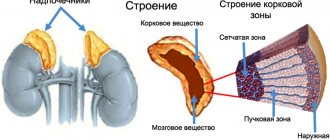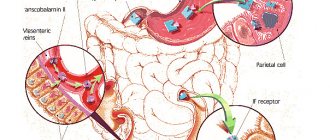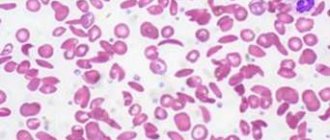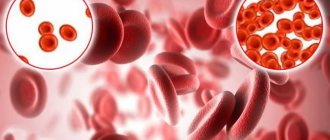Anemia is called megaloblastic if precursor cells (megaloblasts) are “to blame” for its origin. The term is characteristic of the division of all types of anemia based on the principle of morphological changes in cellular composition. In the International Classification of Diseases, such a diagnosis is mentioned only in the section “Other anemia associated with nutrition” and is coded D53.1.
For practicing doctors, the clinical classification of anemia depending on the cause is more understandable and acceptable:
- from blood loss;
- from disruption of red blood cell production;
- from increased destruction of red blood cells.
In this list, megaloblastic anemia is included in the second group, along with aplastic, iron deficiency, sideroblastic and caused by chronic diseases.
According to medical statistics, a tenth of all anemias belong to this group. The incidence increases with age from 0.1% in young people to 4% after 70 years. Hematologists note the low detection rate of the disease. This is associated with the masking of the main symptoms by the widespread unjustified use of vitamin B12 for various pathologies.
Subtypes of megaloblastic anemias
According to more detailed criteria for the mechanism of impaired erythrocyte synthesis, this type of anemia is divided into 2 subtypes.
Anemia associated with a lack of vitamin B12 and folic acid:
- due to the lack of sufficient quantities in food products;
- due to disruption of the absorption process in the intestines;
- due to altered transport and metabolism;
- due to increased needs of the body.
Another type is megaloblastic anemia, which is not related to B12 and folic acid deficiency; the causes are poorly understood.
Vitamin deficiency may be congenital or acquired. Their content is reduced under the influence of drugs from the groups of antiviral, anti-tuberculosis drugs, and drugs for relieving seizures.
The destructive effects of alcohol and drugs have been proven.
B12 anemia: treatment
Treatment tactics for B12-deficiency anemia are developed by CELT specialists according to diagnostic results and individual patient indications. If the diagnosis is confirmed, treatment will be carried out for life, and every five years an endoscopic examination of the gastric mucosa will be required, eliminating the risk of developing malignant neoplasms.
In order to compensate for the deficiency of the vitamin, the patient is prescribed intramuscular administration. Treatment of diseases and disorders that initiated the development of anemia is carried out:
- elimination of helminths;
- taking digestive enzymes;
- operations for diverticula and malignant tumors;
- food with a high content of animal protein;
- taking glucocorticoids for disorders of the production of internal factor.
If you start treating anemia in a timely manner, your blood counts will return to normal in one and a half to two months. Neurological symptoms persist for up to six months; if treatment was started at an advanced stage, they are irreversible and cannot be cured.
The Department of Hematology at CELT welcomes candidates, doctors and professors of medical sciences with over twenty-five years of practical and scientific experience. You can make an appointment with them online or by contacting our operators. No less experienced and qualified specialists perform septoplasty in the otolaryngology department.
At CELT you can consult a hematologist.
- Initial consultation – 3,500
- Repeated consultation – 2,300
Make an appointment
By making an appointment with a hematologist, you can get a comprehensive consultation. The doctor is competent to treat various blood diseases, most of which can be identified in the early stages and prescribe timely treatment to cope with the disease quickly and easily.
Mechanism of disruption of red blood cell formation
The disease is associated with changes in the DNA synthesis of bone marrow cells, which is why instead of proper red blood cells, erythroblasts are produced, which cannot bind molecular oxygen and carry it throughout the body to organs and tissues.
At the same time, the process of cell maturation or the biochemical synthesis of hemoglobin is not damaged, as in other anemias. The main changes occur in cell division, the balance between the nucleus and protoplasm is disrupted. Nuclear chromosomes are delayed in development and disrupt the structure of the nucleus.
Megaloblasts are much larger in size, the nucleus is not located in the center, the nucleus can be divided into segments
The body itself destroys “low-quality” abnormal cells in the bone marrow; they live half as long as a normal red blood cell. Under the influence of the hormone erythropoietin, the consumption of vitamins B12 and folic acid increases, since they are enzymes of this process. Erythroblasts accumulate in the peripheral blood. At the same time, there is an increase in the process of destruction of granulocytes and platelets in the spleen and intestinal epithelium.
The role of vitamin B12 in the development of anemia
The composition of vitamins in the body depends on the processes of “internal production”, the amount supplied with food, and the possibility of absorption. B12 and folic acid are not synthesized independently. The average level of B12 in the blood is maintained due to sufficient accumulation (4 mcg is absorbed daily).
For a deficiency to occur, it must not be supplied in food for years or the destruction process must sharply intensify. The importance for biochemical processes is associated with the presence in the vitamin formula of two essential coenzymes (methylcobalamin and deoxyadenosylcobalamin).
Methylcobalamin is necessary for DNA synthesis, and through this process they ensure the normal process of hematopoiesis, the “ripening” of red blood cells, leukocytes and platelets. Its deficiency leads to the megaloblastic type. Deoxyadenosylcobalamin is an active enzyme in fat metabolism. With a deficiency, the structure of the nerve roots of the spinal cord is disrupted.
All membranes of the spinal cord pass on to the nerve roots, a lack of vitamin causes the destruction of the protective coating
In order for vitamin components to be released from food products, pancreatic protease enzymes are needed. Only they are capable of destroying molecules blocked by protein. For further absorption in the large intestine, constant acidity and calcium ions are required. In the form of transcobalamin, it is delivered to liver cells and bone marrow.
The liver accumulates the vitamin and releases it into the intestines with bile. B12 deficiency, in addition to anemia and neurological symptoms, contributes to disruption of the stomach and intestines.
B12 anemia: causes
The daily requirement of the human body for vitamin B12 is from one to five micrograms. It is satisfied through its consumption with food: after entering the stomach, the vitamin is separated from protein under the influence of enzymes. In order for the body to fully absorb it, a process of connection with glycoprotein and other factors must occur. Absorption of the vitamin into the blood occurs in the lower part of the ileum, from where it passes to the tissues. Factors that can initiate the development of anemia are divided into two groups:
- Nutritional – an unbalanced diet that is unable to ensure the required amount of B12 enters the body. This often happens if the patient practices fasting, vegetarianism, or diets that minimize or eliminate the consumption of animal protein;
- Endogenous – disruptions in the process of vitamin absorption due to a deficiency of protein that binds the vitamin and converts it into an absorbable form. A similar phenomenon can be initiated by: a congenital absence of the internal Castle factor;
- inflammatory processes of the gastric mucosa in a chronic form;
- condition after gastric excision surgery;
- condition after partial removal of the ileum or duodenum;
- inflammation of the small intestine (enteritis), pancreas (pancreatitis);
- gluten enteropathy;
- granulomatous inflammation of the digestive tract (Crohn's disease);
- protrusions of the intestinal wall - (diverticula);
- neoplasms of the jejunum of a malignant nature;
- helminthic infestations caused by different types of helminths.
The reasons may lie in physical and mental dependence on alcohol intake, in the use of Colchicine, Neomycin, as well as a number of oral contraceptives.
The role of folic acid in the development of anemia
Folic acid in the form of salts (folates) enters the body with food. Unlike B12 reserves, folates run out within a month (up to 4 months are possible) after delivery from the duodenum ceases. Absorption of folic acid occurs in the small intestine. The carrier protein delivers the vitamin to the liver and bone marrow.
The further role of folates depends entirely on the presence of cyanocobalamin. With a lack of B12, they cannot participate in the process of DNA synthesis in cells. Accordingly, the synthesis of blood elements is disrupted. Abnormal megaloblasts develop.
Prevention and prognosis
To prevent the development of anemia, the following recommendations must be followed:
- Eat right by eating foods rich in vitamins B9 and B12.
- Lead a healthy lifestyle, give up alcoholism.
- Avoid situations that could lead to parasite infection.
- Treat all diseases of the digestive system in a timely manner.
As for the prognosis, with timely treatment it is favorable and it is possible to completely get rid of anemia.
Who develops B12 deficiency with folic acid
The most common causes of deficiency are:
- vegetarianism and passion for fashionable diets for weight loss;
- diseases of the stomach and intestines associated with diarrhea and impaired absorption of food;
- diphyllobothriasis is a disease from the group of helminthiasis, infection with tapeworm eggs occurs through dirty hands, fish, in the Russian Federation, focal areas along northern rivers, in the Urals and the Far East;
- pregnancy with uncompensated expenses (anemia can be transmitted to the fetus);
- chronic alcoholism.
The broad tapeworm lives in the human body for years, sucking out vitamins
Clinical symptoms
The symptoms are best studied for Addison-Biermer anemia. There are 2 stages of flow:
- initial (preclinical) - there are no patient complaints, manifestations can be detected by chance only by laboratory tests, especially if they are carried out after stressful situations;
- clinical - typical symptoms appear.
Common symptoms of anemia include:
- dizziness;
- complaints of general malaise, weakness;
- nausea and loss of appetite;
- inflammation and burning sensation of the tongue;
- the appearance of painful ulcers on the oral mucosa (stomatitis);
- yellowing of the skin due to an increase in the level of bilirubin in the blood and damage to liver cells.
Megaloblastic anemia is characterized by damage to the nervous system (due to destruction of the spinal cord roots), which manifests itself:
- tingling in fingers;
- impaired skin sensitivity;
- difficulty in movement.
In case of brain damage and severe course, the following are possible:
- memory impairment;
- hallucinations, delusions;
- increased irritability;
- coma.
B12 anemia: symptoms
The clinical picture of megaloblastic anemia is determined by the severity of four syndromes:
| Syndrome | Clinical manifestations |
| Anemic | Symptoms of B12 deficiency anemia are nonspecific because they arise due to failures in the transport of oxygen by red blood cells. They are:
In the long term, anemia can develop into secondary myocardial damage and heart failure. |
| Gastroenterological | One of the classic clinical manifestations is the so-called “lacquered” raspberry tongue. The rest are as follows:
Diagnosis of B12-deficiency anemia reveals atrophy of the gastric mucosa and decreased secretion production. |
| Neurological | The symptoms of this group are caused by damage to neurons and pathways, which manifests itself:
Neurological examination reveals damage to the peripheral nerves and spinal cord. |
The lack of adequate treatment can cause the development of complications in the form of anemia and degenerative processes of the nerves due to the increased sensitivity of the bone marrow and tissues of the nervous system to the lack of B12 in the body.
Diagnostics
A general blood test allows you to suspect anemia at the preclinical stage. The general analysis reveals:
- decrease in the number of red blood cells;
- increasing their size;
- high color index (more than 1.1);
- unchanged hemoglobin content;
- under a microscope, remnants of nuclei in the form of rings and inclusions are detected in erythrocytes;
- decrease in the number of reticulocytes, neutrophils, platelets;
- all cells are increased in size.
Analysis of bone marrow punctate is carried out before the start of treatment with vitamin injections, since the morphological structure changes within 24 hours after the first administration of the drug.
In the bone marrow composition:
- cells of the erythrocyte lineage predominate;
- a discrepancy is detected between their nucleus and cytoplasm;
- disruption of other lineages is confirmed by large neutrophils and megakaryocytes.
In biochemical tests
- moderate increase in free bilirubin;
- serum iron is slightly increased;
- an increase in LDH (lactate dehydrogenase enzyme, indicating increased destruction of red blood cells) is detected.
Conducting a quantitative analysis for the content of B12 and folic acid is possible only in specialized laboratories in hematology departments. This study allows us to determine the exact cause of anemia.









